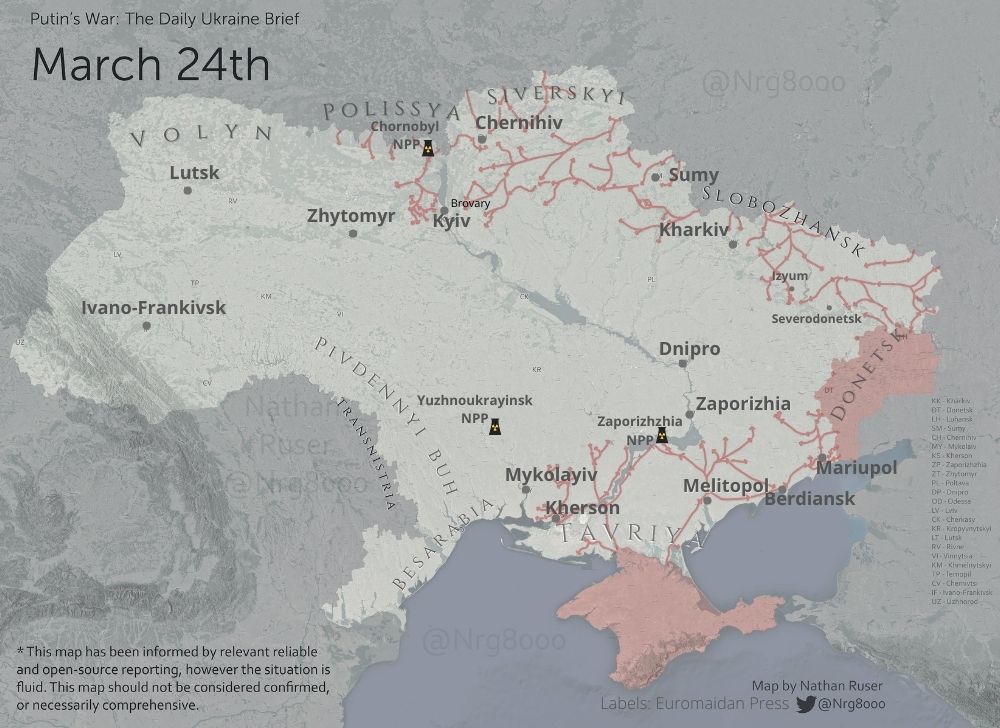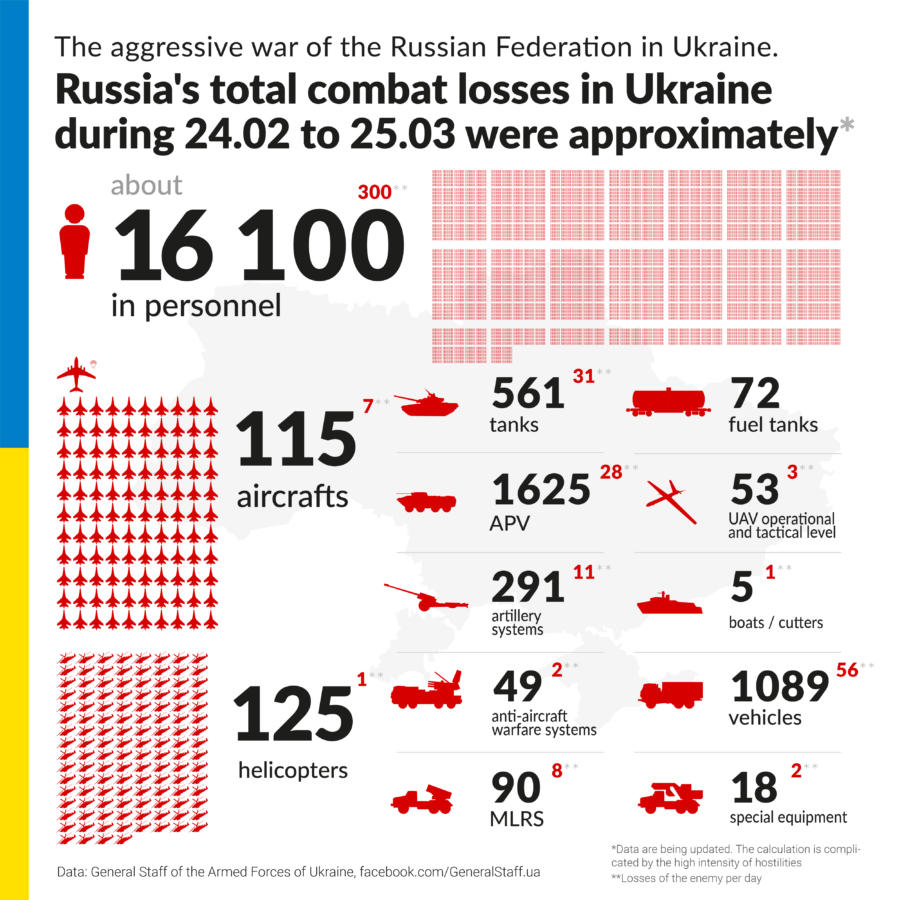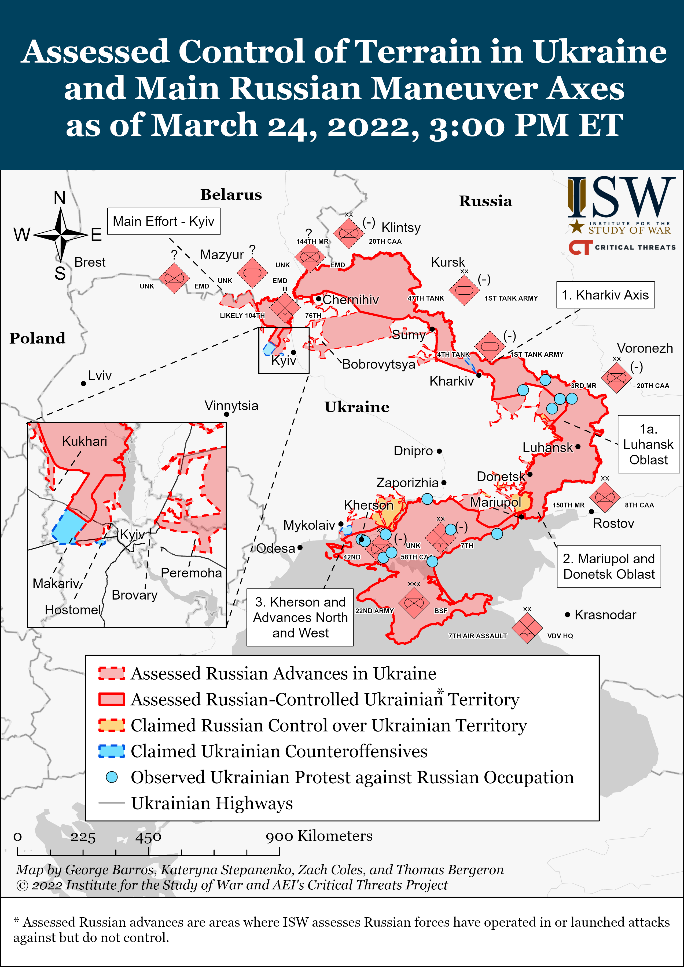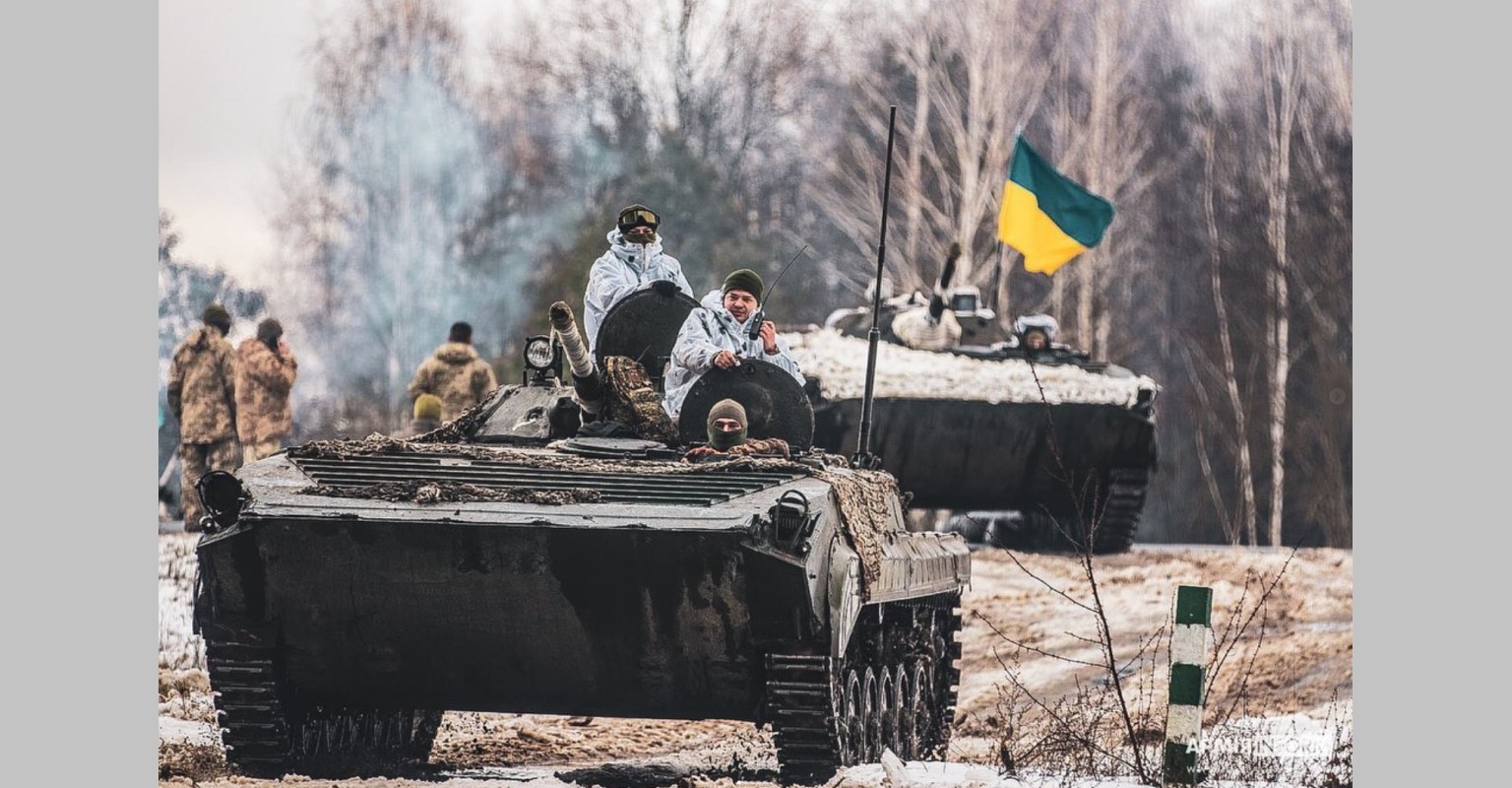Ukraine sank a Russian landing ship on the Russian invasion’s day 29, March 24. On that day, the Ukrainian forces also counterattacked north of Kyiv and repelled another Russian advance attempt near Brovary, Kyiv Oblast, while the Russian troops managed to enter central Mariupol and secured several minor advances in the Donbas.
The report is based on media reports, expert analyses, and official information posted online.
Situation
According to information from Ukraine’s General Staff as of 06.00 25.03.2022, supplemented by its [midnight assessment]:
The [Ukrainian] joint forces are conducting a sustained defensive operation in the Donetsk, Slobozhansky, and parts of the Tavriya areas in the designated operational zone, focusing their efforts on preventing enemy breakthroughs.
[The occupiers’ tasks of reaching the administrative borders of Donetsk and Luhansk oblasts, encircling the city of Kyiv, and establishing control over the left-bank part of Ukraine have not been fulfilled. The enemy managed to partially succeed in the Donetsk operational district in continuing the temporary maintenance of the land corridor between the Rostov region and the TOT of the Autonomous Republic of Crimea.]
[The enemy continues to replenish losses by training and relocating reserve units of the armed forces of the Russian Federation.]
[The enemy did not carry out offensive operations in the Volyn direction.]
In Volyn, the main efforts of the defense forces are focused on covering the state border.
[In the Polissya direction, the enemy did not carry out offensive operations with a certain group, continued to carry out artillery and airstrikes, and tried to restore the position of its forces in the areas of Kyiv and Makarov.]
[In the northern direction, the enemy is trying to concentrate forces and means to resume offensive operations with the help of certain units. It makes unsuccessful attempts to block Chernihiv.]
[In the Brovary direction it moved to the defense, carries out engineering equipment positions. Probably, the enemy will try to resume offensive operations in the direction of the cities of Brovary and Boryspil to block the capital of Ukraine, the city of Kyiv, from the east.]
A defense operation continues in the Siverskyi region. A group of troops holds the city of Chernihiv and hinders the advance of the enemy in the direction of Kyiv.
At the same time, the grouping of forces and means of defense of the city of Kyiv continues to repel the enemy’s offensive, inflict fire damage on it and maintain all the defined lines of defense.
[In the Slobozhansky direction, the enemy is blocking the cities of Sumy and Kharkiv. It strikes on civilian infrastructure. Trying to resume offensive operations in the area of the city of Izium, it bears losses.]
[The withdrawal of certain units of the occupying forces operating in the area to the territory of the Russian Federation is noted due to the loss of more than 50 percent of the personnel.]
[In the Donetsk direction, the enemy holds the occupied frontiers. The main efforts focus on capturing the cities of Popasna, Rubizhne, and Mariupol, are without success.]
[Up to five Battalion Tactical Groups moved to the defense in the Zaporizhzhia direction.]
In the South, the defense operation continues in the designated operational zone, a stabilization operation is underway, and territorial defense tasks are being performed.
[In the Pivdennyi Buh directions, the enemy is occupying the established lines of defense with the forces of the group, trying to take measures to restore the combat capability of units and replenish records.]
[In the Azov operational zone, according to updated information, Ukraine sank Russia’s large landing ship “Saratov” during the attack on the occupied Berdiansk port. Large landing ships “Tsezar Kunikov” and “Novocherkassk” were damaged. Other losses of the enemy are being clarified.]
So, during the previous day, our soldiers repulsed 9 enemy attacks, destroyed 12 tanks, about 20 units of armored and automotive equipment, and 9 artillery systems. The enemy lost more than 200 servicemen. Air defense units shot down 2 planes and 2 enemy UAVs.
The group of the Air Force of the Armed Forces of Ukraine for the previous day hit 6 enemy air targets: 1 plane, 1 UAV, and 4 cruise missiles. The Air Force patrolled the airspace, destroyed the troops and facilities, and fired on the armored personnel carriers, logistics centers, and clusters of enemy troops.
Russian terrorist forces continue to fight, knowingly violating international humanitarian law and the rules of war.”
Resistance forces in Chernihiv oblast have allegedly attacked a column of Russian forces, destroying two armored vehicles and an unspecified number of soldiers, the General Staff of Ukraine claim.

According to British Defence Intelligence, (last 24 hours):
- Ukrainian counter-attacks, and Russian Forces falling back on overextended supply lines, have allowed Ukraine to re-occupy towns and defensive positions up to 35 kilometers east of Kyiv.
- Ukrainian Forces are likely to continue to attempt to push Russian Forces back along the north-western axis from Kyiv towards Hostomel Airfield.
- In the south of Ukraine, Russian Forces are still attempting to circumvent Mykolaiv as they look to drive west towards Odesa with their progress being slowed by logistic issues and Ukrainian resistance.
- Ukrainian forces have launched strikes against high-value targets in Russian-occupied areas of Ukraine, including a landing ship and ammunition storage depots at Berdiansk.
- It is likely that the Ukrainians will continue to target logistical assets in Russian-held areas. This will force the Russian military to prioritize the defense of their supply chain and deprive them of much-needed resupply for forces.
- This will reduce Russia’s ability to conduct offensive operations, and further damage already dwindling morale.
As of Thursday 24.03.2022, the approximate losses of weapons and military equipment of the Russian Armed Forces from the beginning of the war to the present day:

Humanitarian
According to UNHCR 3,674,952 refugees have been registered as of 23 March. The UN says that so far Poland has taken in 2,173,944 refugees, Romania 563,519, Moldova 374,059, Hungary 330,877, Russia 271,254, Slovakia 260,244 and Belarus 5,569.
More than half of Ukrainian children have become refugees or internally displaced persons (UNICEF). One month of the war in Ukraine has led to the displacement of 4.3 million children – more than half of the country’s estimated 7.5 million child population. This includes more than 1.8 million children who have crossed into neighboring countries as refugees and 2.5 million who are now internally displaced inside Ukraine.
Thursday 24 March, the first full-fledged exchange of prisoners of war took place. In exchange for 10 captured Russians, Ukraine received 10 of its servicemen in return, according to Deputy Prime Minister, Iryna Vereshchuk. Additionally, 11 Russian civilian sailors rescued from a sunken ship near Odesa were sent to Russia, in exchange for 19 Ukrainian sailors from the rescue ship “Sapphire”, which was captured by the occupiers while trying to take our troops from the island of Snake.
Legal
Ukraine accuses Moscow of forcibly removing civilians to Russia, Sky News reports.
“Lyudmyla Denisova, Ukraine’s ombudsperson, said 402,000 people, including 84,000 children, had been taken against their will into Russia, where some may be used as hostages to pressure Kyiv to surrender. The Kremlin gave nearly identical numbers for those who have been relocated but said they wanted to go to Russia.”
In a press statement by Antony J. Blinken, Secretary Of State March 23, states:
“Since launching his unprovoked and unjust war of choice, Russian President Vladimir Putin has unleashed unrelenting violence that has caused death and destruction across Ukraine. We’ve seen numerous credible reports of indiscriminate attacks and attacks deliberately targeting civilians, as well as other atrocities. Russia’s forces have destroyed apartment buildings, schools, hospitals, critical infrastructure, civilian vehicles, shopping centers, and ambulances, leaving thousands of innocent civilians killed or wounded. Many of the sites Russia’s forces have hit have been clearly identifiable as in-use by civilians. […] Putin’s forces used these same tactics in Grozny, Chechnya, and Aleppo, Syria, where they intensified their bombardment of cities to break the will of the people. Their attempt to do so in Ukraine has again shocked the world and, as President Zelenskyy has soberly attested, “bathed the people of Ukraine in blood and tears.” Every day that Russia’s forces continue their brutal attacks, the number of innocent civilians killed and wounded, including women and children, climbs. […]
Today, I can announce that, based on information currently available, the US government assesses that members of Russia’s forces have committed war crimes in Ukraine. Our assessment is based on a careful review of available information from public and intelligence sources. As with any alleged crime, a court of law with jurisdiction over the crime is ultimately responsible for determining criminal guilt in specific cases. The US government will continue to track reports of war crimes and will share information we gather with allies, partners, and international institutions and organizations, as appropriate. We are committed to pursuing accountability using every tool available, including criminal prosecutions.”
Since the beginning of the full-scale invasion, the Russian occupants have committed 148 crimes against journalists and the media, the Centre for Defence Strategies reports. In particular, as of March 24, 5 journalists were killed, 7 were wounded, and 1 went missing. In addition, there are at least 6 cases of journalists being taken hostage and ill-treated by Russian. The occupants fired at 10 TV towers, which led to the complete or temporary disappearance of broadcasting in eight regions of Ukraine. In addition, at least 70 regional media outlets were forced to shut down due to threats from the Russian occupants (Institute of Mass Media).
Support
The United States imposed fresh sanctions on dozens of Russian defense companies, hundreds of members of its parliament, and the chief executive of the country’s largest bank Thursday 24 March, Reuters reports.
The UK has imposed sanctions on 65 more Russian people and businesses aimed at cutting off “vital industries fuelling Putin’s war machine“, the foreign secretary said on Thursday, Sky News reports. Liz Truss announced the fresh sanctions, which include the Wagner Group of Russian mercenaries and Alfa-Bank, Russia’s largest private bank. The foreign secretary said defense companies and Russian railways have also been targeted in the latest round of sanctions imposed by the UK.
NATO agreed to increase support for Ukraine, including on cyber security, and chemical, biological, radiological, and nuclear attacks during the extraordinary summit on 24 March. Allies will continue to impose unprecedented costs on Russia to bring about an end to the war in Ukraine.
New developments
- Ukraine’s lead negotiator says talks with Russia could take months, ABC News reports. “Ukraine’s lead negotiator in peace talks with Russia has said he believes the negotiations with Moscow are ‘absolutely real,’ but has warned it may take months to reach a deal to end the war.”
- Allied leaders agreed to reset NATO’s longer-term deterrence and defense posture across all domains, land, sea, air, cyber, and space. They also approved four new multinational NATO battlegroups, in Bulgaria, Hungary, Romania, and Slovakia at an extraordinary Summit in Brussels on 24 March.
- NATO Allies agreed today (24 March 2022) to extend the mandate of Secretary-General Jens Stoltenberg by a further year, until 30 September 2023.
- Thursday, G7 met in Brussels to further strengthen cooperation in light of Russia’s unjustifiable, unprovoked and illegal aggression and President Putin’s war of choice against independent and sovereign Ukraine. “We underline our resolve to impose severe consequences on Russia, including by fully implementing the economic and financial measures we already imposed. We will continue to cooperate closely, including by engaging other governments on adopting similar restrictive measures to those already imposed by G7 members and on refraining from evasion, circumvention, and backfilling that seek to undercut or mitigate the effects of our sanctions.”
- US economic war against Russia can completely collapse bilateral relations, the Russian Ministry of Foreign Affairs states. The USA has declared economic war on Russia, which threatens to completely collapse bilateral relations, Russian Foreign Ministry spokeswoman Maria Zakharova said on Thursday. “The economic war declared on Russia threatens to completely collapse bilateral relations. This, of course, is not in our interests, because we proceed from the fact that diplomatic relations and, in principle, relations between states should serve national interests, the interests of the peoples living on the territory of our countries,” Zakharova said.”
Assessment
On the War
The Institute for the Study of War has made the following assessment as of Thursday 24 March:
 The Ukrainian government and military directly stated for the first time on March 24 that the Kremlin believes its invasion of Ukraine has entered a second, “protracted” phase. The head of Zelensky’s office, Mykhailo Podoliak, stated that Russia seeks to turn the war into a partially “protracted phase” due to high losses in personnel and equipment and the lack of significant progress in any direction. Podoliak stated the Kremlin is changing its tactics and going on the defensive to reduce Russian casualties “to an acceptable (from a propaganda point of view) level.” The Ukrainian General Staff similarly stated that the Russian military leadership is “beginning to realize that the available forces and means are not enough to maintain the temporarily occupied territories of Ukraine and are conducting defensive operations.” ISW previously assessed on March 19 that Ukrainian forces have defeated the initial Russian campaign of the war and that Russian forces would likely go over to the defense.
The Ukrainian government and military directly stated for the first time on March 24 that the Kremlin believes its invasion of Ukraine has entered a second, “protracted” phase. The head of Zelensky’s office, Mykhailo Podoliak, stated that Russia seeks to turn the war into a partially “protracted phase” due to high losses in personnel and equipment and the lack of significant progress in any direction. Podoliak stated the Kremlin is changing its tactics and going on the defensive to reduce Russian casualties “to an acceptable (from a propaganda point of view) level.” The Ukrainian General Staff similarly stated that the Russian military leadership is “beginning to realize that the available forces and means are not enough to maintain the temporarily occupied territories of Ukraine and are conducting defensive operations.” ISW previously assessed on March 19 that Ukrainian forces have defeated the initial Russian campaign of the war and that Russian forces would likely go over to the defense.
The Ukrainian General Staff stated on March 24 that the Kremlin is prioritizing restoring combat capabilities in VDV (airborne) units. The General Staff reported Russian commanders are increasingly deploying reserve officers, conscripts, and obsolete armored vehicles to replace losses.
Key Takeaways
- Russian forces entered central Mariupol on March 24 and continued to take ground across the city. Local Ukrainian authorities left the city in order to better coordinate regional operations amid the deteriorating situation in Mariupol itself.
- Ukrainian forces conducted a successful attack on Russian ships docked at the occupied port of Berdiansk, likely sinking a landing ship and damaging or sinking another. Ukraine’s demonstrated ability to inflict serious damage on Berdiansk may disrupt Russian forces from renewing attempts to reinforce operations in Mariupol and around Kherson by sea.
- Ukrainian forces did not retake any territory in continuing counterattacks northwest of Kyiv but forced Russian troops onto the defensive.
- Ukrainian forces repelled renewed Russian attempts to advance toward Brovary from the northeast and complete the encirclement of Chernihiv.
- Russian forces continue to shell Kharkiv and struck a humanitarian aid delivery point, killing six and wounding 15.
- Russian forces secured several minor advances in Donetsk and Luhansk oblasts in the last 24 hours.”
Consequences and what to do?
During President Bidens press conference Thursday, one month after the Russian invasion started, he stressed his most important objective was to have absolute unity among NATO allies on 3 key important issues, (1) support Ukraine with military and humanitarian assistance, (2) to impose the most significant economic sanctions ever to cripple Putin’s economy and punish him for his actions, (3) and fortify the eastern flank of NATO. The Alliance has accomplished all three of these, President Biden stated.
During the press conference of NATO Secretary-General, Jens Stoltenberg, he described the outcome of that unity of efforts.
Support to Ukraine with military and humanitarian assistance.
Allies have been equipping Ukraine with significant military supplies, including anti-tank and air defense systems, and drones, as well as substantial financial and humanitarian aid.
During the summit, NATO agreed to do more, including cybersecurity assistance and equipment to help Ukraine protect against biological, chemical, radiological, and nuclear threats. This could include detection, protection, and medical supplies, as well as training for decontamination and crisis management.
The General Secretary stressed that NATO is determined to do all we can to support Ukraine. Unfortunately, that does not include boots on the ground and a peacekeeping force, a No-Fly Zone, combat aircraft, medium or long-range Air Defence systems. He was unable to respond to President Zelensky’s plea for “1% of all your tanks, for 1% of all your aircraft, for multi-launch rocket systems, anti-ship weapons, and means of air defense”.
To impose the most significant economic sanctions ever to cripple Putin’s economy and punish him for his actions.
Stoltenberg mentioned sanctions briefly, highlighting that NATO impose the sanctions because it is important to end the war immediately. The lack of substance is logical since the Alliance does not impose economic sanctions. The member states (the USA and the UK) and the EU impose sanctions.
President Biden, however, stressed that sanctions are not meant to deter, but to increase the pain to the point that the Russian economy is crippled, and President Putin is no longer able to continue the war in Ukraine. He emphasized that he was ready to sustain the sanctions until the end of the year if required. He did, however, not expect to see any effects for at least a month.
Fortify the eastern flank of NATO.
The Secretary-General highlighted that NATO is resetting its long-term deterrence and defense posture, with more troops, with more air assets, and more maritime capabilities. The alliance has already increased its presence in the east and Thursday decided to establish four new battlegroups. The member states agreed to task NATO military commanders to provide options for a long-term reset of our presence, of our military posture in the eastern part of the Alliance and across the whole Alliance.
NATO leaders agreed to redouble efforts to meet the Defence Investment Pledge made in 2014. Allies will submit additional plans on how to meet the pledge in time for the Madrid Summit in June.
“So this is long term, we are prepared for the long haul because we can already today say that the Russian invasion, President Putin’s invasion of Ukraine has changed our security environment for the long term. It is a new reality. It is a new normal and NATO is responding for the long term.”
Neither president Biden nor Secretary General Stoltenberg, however, mentioned NATO’s red lines. The Alliance is dead set on not defining any criteria that might invertible pull NATO into the conflict. Nor did they mention the preconditions for lifting the sanctions.
It is important to remember that the sanctions do not have a global application. Not everyone wants to make Putin an economic pariah over the Ukraine war. China, along with India, Bangladesh, Pakistan, Indonesia, Brazil, and Mexico, has signaled a desire to maintain trade ties and other links with Russia, LA Times reports.
“Beyond this fortified coalition, very few nations have chosen to take part in the economic warfare set against the Putin government,” David Adler, general coordinator of Progressive International, a group that promotes left-leaning organizations and causes, wrote in a March 10 op-ed in Britain’s Guardian newspaper.
Both reiterated the “mantra” that “we have a responsibility to ensure that this conflict does not become a full-fledged war between NATO and Russia” while at no time addressing the point that Russia already sees it as a party to the conflict. According to Russia, the war is essentially about NATO, including its threat to Russian security as a consequence of its “eastward expansion since 1997” and its basing and air and maritime operations within striking distance of Moscow. The fact that the Alliance (in the eyes of the Russian leadership) is waging political and economic warfare against Russia while delivering weapons to Ukraine is seen as a hostile act.
This brings us back to two key statements. Firstly, President Biden stressed the crucial importance of absolute unity among NATO allies. Secondly, Secretary General Stoltenberg highlighted that NATO is determined to do all we can to support Ukraine. Both indicate discord within the Alliance and that the outcome is the upper limit of what the “weakest links” are willing to accept, in the fear that a greater engagement will result in unacceptable costs to individual member states. Recognizing the fundamental dependency of many European countries on Russian oil and gas, one can argue that the Russian Federation in the short term has succeeded in limiting NATO’s ability to respond to its war in Ukraine.
This puts Stoltenberg’s statement about the importance of ending this war immediately in a somewhat different light. Both Biden and Stoltenberg address the long-term commitment since the present NATO strategy does not support any other aim. The only way to end the war immediately would be to do what the Alliance presently is unable to do: to engage actively and send in a peace enforcement force under a UN mandate.
This means we will see more senseless suffering, horror, destruction, and Russian atrocities before the war ends. It also brings a new sense of urgency into President Putin’s effort to defeat and subjugate Ukraine no matter what it takes. He knows that he still has a limited window of opportunity before he loses the ability to wage war. He desperately needs a peace agreement (“Minsk agreement 3.0”) to make sure the West disengages and starts lifting sanctions.
I fear that the aim of achieving full unity in the face of the massive atrocities taking place in Ukraine will come back and haunt NATO. I cannot see anything that might cut the war short but the active role of NATO. I believe in NATO deterrence, and if deterrence works, Russia will step back if the Alliance chose a more active role. By not defending Ukraine, we might both see a protracted war with horrific atrocities as well as global consequences that might come back and challenge NATO and EU unity.








